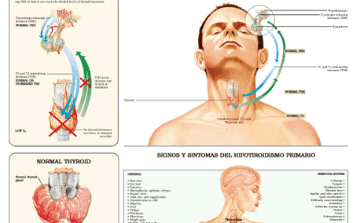Your thyroid gland may be tiny, but it plays a big role in how well your body functions. That’s because the thyroid produces a hormone that regulates your metabolism, the process that converts what you eat and drink to energy. When you have hypothyroidism, or an underactive thyroid, your metabolism slows, causing you to gain weight more easily and feel sluggish and fatigued. Too little thyroid hormone also can mean too much bad fat, or LDL cholesterol, in your bloodstream. The thyroid hormone helps the liver break down the cholesterol circulating in your blood and stimulates other enzymes needed to rid your body of triglycerides, another type of blood fat. When you don’t have enough thyroid hormone, your LDL and triglycerides can rise.
 Exercising with either uncontrolled hyperthyroidism (overactive thyroid) or hypothyroidism (underactive thyroid) can be dangerous to your health as these conditions increase or depress people’s metabolism, respectively — speeding up or slowing down their heart rate. What’s the best type of exercise for hypothyroidism? A program of low-impact aerobic exercises and strength training. Low-impact aerobics get your heart rate up and your lungs going without putting too much pressure on your joints, which is important because joint pain is another common hypothyroidism symptom.
Exercising with either uncontrolled hyperthyroidism (overactive thyroid) or hypothyroidism (underactive thyroid) can be dangerous to your health as these conditions increase or depress people’s metabolism, respectively — speeding up or slowing down their heart rate. What’s the best type of exercise for hypothyroidism? A program of low-impact aerobic exercises and strength training. Low-impact aerobics get your heart rate up and your lungs going without putting too much pressure on your joints, which is important because joint pain is another common hypothyroidism symptom.
People with hypothyroidism can also benefit from strength training — exercises such as lunges, leg raises, and push-ups or those involving weight-training machines. Strength training builds muscle mass, and muscle burns more calories than fat, even when you’re at rest. Building muscle can help counter possible weight gain from an underactive thyroid.
 For people with significant hyperthyroidism (commonly caused by the autoimmune disorder Graves’ disease), exercise can “overheat” the body in a dangerous way. There are several exercises that are beneficial for people suffering from hyperthyroidism. First on the list is aerobic exercise, which you can do up to five days per week for 30 to 60 minutes per day. The best aerobic exercises engage the large muscles of your body, which could include taking a dance class, biking or swimming. Do resistance training two or three days per week, with at least 48 hours between sessions that focus on the same muscles. Resistance exercises include using resistance bands, doing heavy gardening or doing body-weight exercises such as push ups and sit ups. Do weight-bearing activities to help prevent osteoporosis, including walking and stair climbing, suggests the National Institutes of Health.
For people with significant hyperthyroidism (commonly caused by the autoimmune disorder Graves’ disease), exercise can “overheat” the body in a dangerous way. There are several exercises that are beneficial for people suffering from hyperthyroidism. First on the list is aerobic exercise, which you can do up to five days per week for 30 to 60 minutes per day. The best aerobic exercises engage the large muscles of your body, which could include taking a dance class, biking or swimming. Do resistance training two or three days per week, with at least 48 hours between sessions that focus on the same muscles. Resistance exercises include using resistance bands, doing heavy gardening or doing body-weight exercises such as push ups and sit ups. Do weight-bearing activities to help prevent osteoporosis, including walking and stair climbing, suggests the National Institutes of Health.
Therefore one should keep in mind that physical activity influences the metabolism and has also been proven to increase the rate at which a person burns calories during exercise and also after exercise. In a study performed with 60 male athletes, the men performed moderate to high intensity bicycling and their levels of thyroid hormone were measured before and after the workout. This study determined that during moderate-intensity exercise, the amount of thyroid hormone circulating in the body increased. During an aerobic activity, the thyroid gland is stimulated to produce higher amounts of the hormone. Exercise boosts the thyroid function both during and also hours after exercise. However, without consistent exercise, the thyroid may continue to stop producing as much of this metabolism-boosting hormone. Regular physical exercise that is moderate in intensity ensures that your thyroid gland continues to produce enough thyroid hormone to keep your metabolism at a healthy level.
Do you want to find an effective Thyroid treatment? Check out our top rated Thyroid products











